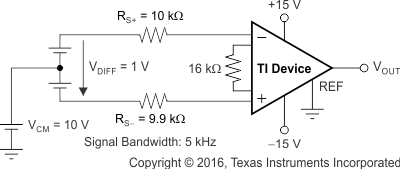ZHCS968B June 2012 – November 2017 INA827
PRODUCTION DATA.
- 1 特性
- 2 应用
- 3 说明
- 4 修订历史记录
- 5 Pin Configuration and Functions
- 6 Specifications
- 7 Typical Characteristics
- 8 Detailed Description
- 9 Application and Implementation
- 10Power Supply Recommendations
- 11Layout
- 12器件和文档支持
- 13机械、封装和可订购信息
8.3.10 Error Sources
Most modern signal-conditioning systems calibrate errors at room temperature. However, calibration of errors that result from a change in temperature is normally difficult and costly. Therefore, these errors must be minimized by choosing high-precision components such as the INA827 that have improved specifications in critical areas that effect overall system precision. Figure 60 shows an example application.
 Figure 60. Example Application With G = 10 V/V and 1-V Differential Voltage
Figure 60. Example Application With G = 10 V/V and 1-V Differential VoltageResistor-adjustable INAs such as the INA827 yield the lowest gain error at G = 5 because of the inherently well-matched drift of the internal resistors of the differential amplifier. At gains greater than 5 (for instance, G = 10 V/V or G = 100 V/V) gain error becomes a significant error source because of the resistor drift contribution of the feedback resistors in conjunction with the external gain resistor. Except for very high gain applications, gain drift is by far the largest error contributor compared to other drift errors (such as offset drift). The INA827 offers the lowest gain error over temperature in the marketplace for both G > 5 and G = 5 (no external gain resistor). Table 2 summarizes the major error sources in common INA applications and compares the two cases of G = 5 (no external resistor) and G = 10 (with a 16-kΩ external resistor). As shown in Table 2, although the static errors (absolute accuracy errors) in G = 5 are almost twice as great as compared to G = 10, there is a great reduction in drift errors because of the significantly lower gain error drift. In most applications, these static errors can readily be removed during calibration in production. All calculations refer the error to the input for easy comparison and system evaluation.
Table 2. Error Calculation
| ERROR SOURCE | ERROR CALCULATION | INA827 | ||
|---|---|---|---|---|
| SPECIFICATION | G = 10 ERROR (ppm) | G = 1 ERROR (ppm) | ||
| ABSOLUTE ACCURACY AT +25°C | ||||
| Input offset voltage (µV) | VOSI / VDIFF | 150 | 150 | 150 |
| Output offset voltage (µV) | VOSO / (G × VDIFF) | 2000 | 200 | 400 |
| Input offset current (nA) | IOS × maximum (RS+, RS–) / VDIFF | 5 | 50 | 50 |
| CMRR (dB) | VCM / (10CMRR / 20 × VDIFF) | 94 (G = 10), 88 (G = 5) |
200 | 398 |
| Total absolute accuracy error (ppm) | 600 | 998 | ||
| DRIFT TO +105°C | ||||
| Gain drift (ppm/°C) | GTC × (TA – 25) | 25 (G = 10), 1 (G = 5) |
2000 | 80 |
| Input offset voltage drift (μV/°C) | (VOSI_TC / VDIFF) × (TA – 25) | 5 | 200 | 200 |
| Output offset voltage drift (μV/°C) | [VOSO_TC / ( G × VDIFF)] × (TA – 25) | 30 | 240 | 240 |
| Total drift error (ppm) | 2440 | 760 | ||
| RESOLUTION | ||||
| Gain nonlinearity (ppm of FS) | 5 | 5 | 5 | |
| Voltage noise (1 kHz) |  |
eNI = 17 eNO = 250 |
6 | 6 |
| Total resolution error (ppm) | 11 | 11 | ||
| TOTAL ERROR | ||||
| Total error | Total error = sum of all error sources | 3051 | 1769 | |